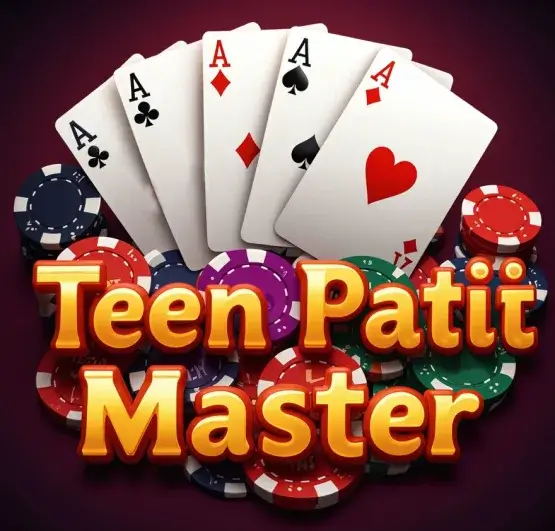How to Download and Install Teen Patti Master App?
Getting started with Teen Patti Master is super easy. Follow these steps to download and install the app:
1️⃣
Visit the official website.
2️⃣ Click on the download button to get the APK file.
3️⃣ Enable "Unknown Sources" in your phone settings (for
Android users).
4️⃣ Install the APK and follow the on-screen
instructions.
5️⃣ Open the app, create an account, and start playing!
How to Download Teen Patti Master APK?
If you prefer downloading the APK version, follow these steps:
1️⃣
Go to the official Teen Patti Master website.
2️⃣ Tap on the "Download APK" button.
3️⃣ Allow downloads from unknown sources in your phone
settings.
4️⃣ Wait for the download to complete.
How to Install Teen Patti Master APK?
After downloading the APK, installing it is quick and simple:
1️⃣ Open the downloaded APK file.
2️⃣ Click "Install" and wait for the process to finish.
3️⃣ Allow permissions if prompted.
4️⃣ Launch the app and sign in or create an account.
How to Create an Account in Teen Patti Master?
Creating an account is the first step to unlocking the full Teen Patti Master experience. Follow these simple steps:
1️⃣ Open the Teen Patti Master app.
2️⃣ Click on "Sign Up" or "Register."
3️⃣ Enter your mobile number or email.
4️⃣ Set a strong password.
5️⃣
Verify your account using the OTP sent to your phone or
email.
6️⃣ Start playing and enjoy exciting rewards!
Benefits of Creating an Account in Teen Patti Master
By signing up, you unlock many amazing benefits:
🎁 Welcome Bonus: Get up to ₹1550 as a new user!
🎟 Exclusive Rewards: Access daily bonuses, free chips,
and special promotions.
🎮 Personalized Experience: Save your progress, track
your winnings, and customize your gameplay.
💰 Real Cash Withdrawals: Play for real money and
withdraw your winnings easily.
🔒 Secure Gaming: Enjoy a safe and fair gaming
environment with top-level security.
Teen Patti Master App Details
Teen Patti Master is an exciting and user-friendly card game app that brings the thrill of Teen Patti to your fingertips. With a smooth interface, fast gameplay, and multiple game modes, it's designed to give players an immersive experience. The app supports both Android and iOS devices, allowing users to play anytime, anywhere. Whether you're a beginner or an experienced player, Teen Patti Master ensures an enjoyable and fair gaming experience. Plus, with secure transactions and 24/7 customer support, you can play with confidence.
Exciting Features of Teen Patti Master
Teen Patti Master is packed with features that make the game more fun and rewarding. Here's what makes it stand out:
- Multiple Game Modes – Play classic Teen Patti, Rummy, Andar Bahar, Dragon vs Tiger, and more!
- Daily Bonuses – Get free chips every day to keep playing without interruptions.
- Fast Withdrawals – Withdraw your winnings quickly and securely within minutes.
- Live Multiplayer Games – Compete with real players from across the world.
- Secure Transactions – Play with confidence using encrypted payments and anti-cheating technology.
- Interactive Gameplay – Enjoy high-quality graphics, animations, and sound effects for a real casino-like feel.
Key Features of Teen Patti Master
Teen Patti Master offers several key features that make it one of the best online card games available:
- Easy to Play – Simple rules and smooth gameplay make it ideal for both beginners and experts.
- 24/7 Customer Support – Get help anytime through live chat and email.
- Private Tables – Create private game rooms and invite friends for exclusive matches.
- Multiple Payment Options – Supports bank transfers, UPI, e-wallets, and other secure payment methods.
- Regular Tournaments – Participate in daily and weekly tournaments for a chance to win big.
- Social Gaming Experience – Chat with players, send gifts, and build your gaming community
Hot Features of Teen Patti Master
Some of the hottest features of Teen Patti Master that make it unique include:
- Teen Patti Speed Mode – A fast-paced version of the game for players who love quick action.
- VIP Membership – Unlock special perks, exclusive bonuses, and higher withdrawal limits.
- Refer & Earn – Invite friends to play and earn real money rewards.
- AI-Powered Fair Play System – Ensures fair dealing and prevents cheating.
- Theme-Based Events – Participate in seasonal events and special promotions for extra rewards.
Teen Patti Master Referral Programme
Teen Patti Master's referral program is a great way to earn extra rewards while sharing the fun with friends. Here's how it works:
- Invite Friends – Share your referral link with your friends and family.
- They Register & Play – When they sign up and start playing, you get a reward.
- Earn Bonuses – Get cash rewards or free chips for every successful referral.
- Keep Earning – The more friends you invite, the more rewards you unlock!
Games Available in Teen Patti Master
Teen Patti Master offers a variety of exciting games that keep players entertained and engaged. Whether you enjoy classic card games or fast-paced action, there's something for everyone. Let's explore the different game options available on the platform.
Multiples Game
For players who love variety, the Multiples Game section offers a mix of different games where you can test your luck and skills. With multiple options to choose from, you'll never run out of thrilling challenges.
Teen Patti Master
Teen Patti Master is the heart of the platform, bringing you India's favorite card game in an exciting online format. Play against real players, place your bets, and aim for the best three-card hand to win big. Whether you're a beginner or an experienced player, the game offers something for everyone.
Rummy
Rummy is a classic card game that requires skill and strategy. The goal is to create valid sets and sequences before your opponents. Teen Patti Master offers different versions of Rummy, allowing players to enjoy this timeless game in a competitive and fun environment.
Slots
If you love spinning the reels and chasing jackpots, the Slots section is for you. Teen Patti Master features a wide range of slot games with different themes and exciting bonus features. Spin, match symbols, and enjoy the thrill of big wins.
Teen Patti Speed
For those who love quick action, Teen Patti Speed is a fast-paced version of the classic game. The rounds are shorter, and the betting happens quickly, making it perfect for players who want an adrenaline rush. Test your reflexes and make strategic moves in this high-energy variant.
Rummy Master
Rummy Master is another exciting variation of the traditional Rummy game. It challenges players to think fast and make the right combinations to win. The game is perfect for those who enjoy using strategy and skill to outplay their opponents.
Slots Meta
Slots Meta offers a premium slot gaming experience with visually stunning designs and exciting features. Players can enjoy different slot themes, free spins, and jackpot rounds for a chance to win big. It's all about luck and fun in this thrilling game mode.
Some Facts About Teen Patti Master
Teen Patti Master is one of the most popular online card game platforms, bringing the excitement of traditional Teen Patti into the digital world. It offers multiple variations of the game, secure transactions, and a vibrant community of players. With fast withdrawals, 24/7 customer support, and exciting bonuses, it has quickly become a favorite among card game lovers in India.
Teen Patti Master Old Version
Before the latest updates and feature-packed versions, Teen Patti Master had older versions that many players still enjoy today. These versions were simple, fast, and free from extra features that some players find unnecessary. Whether for nostalgia or a preference for lightweight gameplay, the old versions still hold a special place in the hearts of many Teen Patti enthusiasts.
Teen Patti Master Old Version Download
If you want to revisit the classic Teen Patti Master experience, you can still find and download its older versions. Many players prefer these versions because they are smooth, fast, and easy to use. Just make sure to download from a reliable source to ensure a safe and secure gaming experience.
Why Players Still Love Teen Patti Master Old Version
Even though newer versions come with more features and improvements, many players still prefer the older versions of Teen Patti Master. Here's why:
Simplicity of Gameplay
The old versions focus purely on Teen Patti without extra distractions. Players can enjoy the game without dealing with too many menus, animations, or features that might slow things down.
Lightweight and Fast
Older versions of Teen Patti Master run smoothly, even on basic smartphones. They require less storage space and work well on slower internet connections, making them a great choice for players who want a quick and seamless gaming experience.
Nostalgia
For long-time Teen Patti players, the older versions bring back memories of when they first started playing. Many users love the classic interface and feel more comfortable with the old design.
No Overcomplicated Features
Some players prefer a straightforward Teen Patti experience without extra buttons, pop-ups, or added game modes. The old versions keep things simple, allowing players to focus on the game itself.
Popular Old Versions of Teen Patti Master
Several past versions of Teen Patti Master remain popular among players. Here are some of the most well-loved ones:
Teen Patti Master Old Version 2021
This version was known for its smooth gameplay and easy-to-use interface. It kept things simple, making it a favorite among players who enjoy classic Teen Patti without too many extras.
Teen Patti Master Old Version 2022
The 2022 version brought some minor improvements while still maintaining the classic feel. It was lightweight and well-optimized, making it a great choice for players who wanted a balance between old and new.
Teen Patti Master Old Version 2023
This version introduced some visual upgrades and slight performance improvements while keeping the fast and straightforward gameplay that players loved. It remains one of the most downloaded older versions.
Advantages of Playing Teen Patti Master Old Version APK
If you prefer the older versions of Teen Patti Master, here are some benefits you'll enjoy:
- Faster Performance: The game runs smoothly on almost any device, even older smartphones.
- Less Storage Space: The older APK files take up less space, making them ideal for devices with limited storage.
- Simpler Gameplay: No unnecessary features—just pure Teen Patti fun.
- Stable and Reliable: Many players find the old versions more stable, with fewer crashes or bugs.
- Nostalgic Experience: For long-time Teen Patti fans, the older versions bring back the classic feel of the game.
Teen Patti Master: Conquer the Tables of India's Most Beloved Card Game
Teen Patti is one of the most loved card games in India, and Teen Patti Master brings the excitement of this classic game to your fingertips. Whether you're a seasoned player or just starting out, this online version lets you test your skills, compete with real players, and win real cash—all from the comfort of your home. The game blends strategy, skill, and luck, making every round thrilling and unpredictable.
Dive into the Heart of Teen Patti Master
Teen Patti Master isn't just about playing cards—it's an immersive experience. The app is designed to be easy to use, with smooth gameplay and realistic graphics that make you feel like you're sitting at a real Teen Patti table. Whether you're playing casually or aiming for big wins, Teen Patti Master offers different game modes to keep things interesting. Plus, with a growing community of players, you'll always find a table to join.
Strategies for Winning at Teen Patti Master
While luck plays a role in Teen Patti, smart strategies can improve your chances of winning. Here are some key tips to help you succeed:
- Start Small: If you're new to the game, begin with lower bets to understand the flow before risking larger amounts.
- Observe Your Opponents: Watch how others bet and fold to pick up on patterns and weaknesses.
- Know When to Fold: If your hand isn't looking strong, don't be afraid to fold early and save your chips for a better round.
- Bluff Smartly: Bluffing can be a great tool, but don't overuse it—experienced players can spot a bluff easily.
- Practice Regularly: The more you play, the better you'll understand the game dynamics and improve your decision-making.
The Social Side of Teen Patti Master
Teen Patti is not just about winning; it's also about having fun and connecting with people. Teen Patti Master allows you to play with friends, chat with other players, and even invite them to private tables. Whether you're playing for fun or competing seriously, the social aspect makes the experience even more enjoyable.
Ensuring Fair Play and Security
Teen Patti Master takes security and fair play seriously. The game uses random number generators (RNGs) to ensure fair dealing of cards, so every player has a genuine chance of winning. Additionally, secure payment options and encryption technology keep your transactions and personal details safe. With 24/7 customer support, help is always available if you need it.
Final Thoughts on Mastering Teen Patti
Teen Patti Master is more than just a game—it's an exciting way to challenge yourself, develop strategies, and have fun while winning real rewards. Whether you're playing casually or aiming to become a pro, the key is to play responsibly and enjoy the experience. Download Teen Patti Master today and join millions of players in India's most thrilling card game adventure!
Search Query:
Teen Patti Master, Teen Patti, TeenPatti Master, 3Patti Master, Master Teen Patti, Teen Patti Master APK, Teen Patti Master APP, Teen Patti Master download, Teenpatti Master 2025, Master Teen Patti app, 3 Patti Master APK, Download Teen Patti Master, Teenpatti Master new version, Teen Patti Master old version, Teen Patti Master APK download, Teenpatti Master online, Teenpatti Master MOD APK, Play Teen Patti Master, Teen Patti Master real cash, Teen Patti Master game, Install Teen Patti Master, Teen Patti Master for Android.
About Us - Teen Patti Download
Teen Patti Master is a top-rated online card game that brings the excitement of traditional Teen Patti straight to your phone. We provide a secure and engaging platform where players can enjoy multiple card games, win real cash, and connect with other players worldwide. Whether you're a beginner or an expert, Teen Patti Master ensures fun, fair play, and big rewards!
About Teen Patti Master Game
Teen Patti Master is a thrilling card game that blends strategy, skill, and luck. Inspired by the popular Indian card game, it offers different variations like Teen Patti Speed, Rummy, and Slots Meta. The game is designed to be user-friendly, making it easy for new players to join while keeping it challenging for seasoned players. With fast cash withdrawals and exciting tournaments, Teen Patti Master is the ultimate destination for card game lovers.
FAQs
(Q.1) What is Teen Patti Master?
Teen Patti Master is an online card game based on the classic Indian Teen Patti. It allows players to bet, bluff, and compete against others to win real cash rewards. With multiple game variations and exciting features, it's one of the most popular online Teen Patti platforms.
(Q.2) How do I download Teen Patti Master?
Downloading Teen Patti Master is easy! Simply visit the official website, click on the download link, and install the APK on your device. For Android users, enable "Unknown Sources" in your settings before installing. iOS users can download it from the App Store.
(Q.3) Is Teen Patti Master free to play?
Yes, Teen Patti Master is free to download and play. You can enjoy various games without spending money. However, if you want to play cash games and win real money, you can deposit funds into your account.
(Q.4) Can I play Teen Patti Master with my friends?
Absolutely! Teen Patti Master lets you invite friends and play private games together. You can also join public tables to compete with players from around the world.
(Q.5) What is Teen Patti Speed?
Teen Patti Speed is a fast-paced version of the classic game where betting rounds are quicker, and players need to make decisions faster. It's perfect for those who love a thrill and want to play more rounds in less time.
(Q.6) How is Rummy Master different from Teen Patti Master?
While both games are card-based, Rummy Master requires players to create sets and sequences to win, while Teen Patti is more about bluffing and betting on the best three-card hand. Rummy involves more strategy, while Teen Patti is a mix of skill and luck.
(Q.7) Is Rummy Master available for all devices?
Yes, Rummy Master is available on both Android and iOS devices. You can download the app from the official website or the App Store, depending on your device.
(Q.8) How do I start playing Slots Meta?
To start playing Slots Meta, simply open the Teen Patti Master app, go to the Slots section, and choose a slot game. Spin the reels, match symbols, and win prizes! No special skills are required—just spin and enjoy.
(Q.9) Are there any strategies for winning in Slots Meta?
Slots Meta is based on luck, but you can increase your chances of winning by playing games with higher payout rates, managing your bankroll wisely, and taking advantage of bonuses and free spins.
(Q.10) Are There Any Age Restrictions for Playing Teen Patti Master?
Yes, players must be at least 18 years old to play Teen Patti Master. This ensures responsible gaming and compliance with online gaming regulations.























